You are reading the older HTML site
Positive Feedback
ISSUE
20
july/august
July 2005 - Here are just some hi-res review selections from our July Issue

Bolivian Baroque = Baroque music from missions of the Chiquitos and Moxos Indians – Florilegium and Bolivian soloists – Channel Classics CCSSA 22105 – Multichannel SACD, 75 min. + Fullscreen DVD with PCM Stereo, 45 min.****
This excellent recording from Channel Classics began when a number of musical texts dating from the early 1700s were discovered in the Church of Concepcion in the Bolivian jungle. The baroque specialty group Florilegium became interested in recording the project, and it was decided that Bolivian singers should be used throughout. The works were staged and recorded in Bolivia, and this multichannel SACD and the accompanying bonus DVD document the proceedings.
The music, while uncredited, is superb, and very much in the Baroque tradition—I found it to be reminiscent of Vivaldi or Telemann, played in historically informed performances. The Bolivian soloists are just sensational, and I wouldn't be at all surprised if Channel Classics chose to record them again—they're really that good! Sound, as always was excellent—I've never heard a bad disc from Channel Classics. My only caveat had to do with the bonus DVD, but then let's emphasize again BONUS DVD! The video wasn't widescreen, it was a bit grainy, and the sound was only PCM stereo. Otherwise, it offered a fascinating insight into the efforts that produced this excellent set and was a highly enjoyable watch. Highly recommended. Tom Gibbs
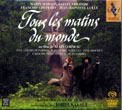
Tous les matins du monde: Music from the film featuring works by Marais, Sainte Colombe, Couperin and Lully – Jordi Savall, Musical Director – Alia Vox 9821 – Multichannel Hybrid SACD, 76 min. *****
The art-house sensation that was the film Tous les matins du monde was based on the novel that made numerous suppositions about the composer Sainte Colombe, about which very little is known. The very best thing about the film, aside from a memorable performance by Gerard Depardieu as Sainte Colombe, was Jordi Savall's superb scoring and performances of works by Marin Marais, Francois Couperin, Jean-Baptiste Lully and the aforementioned Sainte Colombe. While most already familiar with the film and its soundtrack probably have this collection, it's offered here for the first time remastered to multichannel SACD, and the results are spectacular.
The sound quality is first-rate, especially for a nearly-fifteen year-old disc remixed for surround sound—and easily surpasses the original Red Book CD version. The multichannel edition offered an immediacy and depth of field that really enhanced my enjoyment of the music, while eschewing any gimmickry in the surround channels. The music is instantly recognizable, especially the works by Marais—it's really amazing how little of this man's work is part of the mainstream, and yet how very essential it seems in this collection. Five stars—it doesn't get much better than this! Tom Gibbs
MULTICHANNEL DISC SET OF THE MONTH
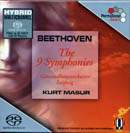
BEETHOVEN: The Nine Symphonies - Gewandhaus Orchestra of Leipzig/Kurt Masur (Rec. 1972-1974) - Pentatone multichannel RQR Series SACD (5-disc set) PTC 5186 159, 5 hrs., 44:57 *****
This Beethoven cycle, originally issued on Philips LPs in 1975 and mixed down to stereo for that purpose, quickly became a standard with collectors as a no-nonsense, straightforward interpretation free of the idiosyncrasies of some of the competition. There may be somewhat less dramatic impact in the big climaxes than one would hear from Reiner, Karajan and their ilk but there is a flow and naturalness that draws one into the music effectively. Toscanini has the drama and emotional depth in spades but by today's standards in execrable sound. Of course the surround sound display is a major factor in the more immersive feeling of these interpretations. The original four channel tapes intended for quad release on vinyl have been transferred directly to the front two channels and the two surrounds, without deriving a center or LFE channel. The Gewandhaus boasts fine acoustics, so the impression of the hall environment adds to the listening experience. Sonically one would never guess that these recordings are more than 30 years old, and the center channel is not really missed.
The Seventh is delivered with an emphasis on its dance-like nature, and the Pastoral Symphony flows thru bucolic pastures with an elan atmosphere. The Third and especially the Ninth are powerful interpretations with a richness of sound and impact. Comparison with the standard CDs of any of the symphonies in my collection—even with surround generated via Pro Logic II—pointed up the great clarity, detail and soundstaging of the RQR recordings. The packaging is in one of those extremely compact little boxes, with the five discs in plain paper sleeves, so it won't take up any more room on your shelf than a double-CD jewel box. Recommended—especially if you eschew the Karajan SACD set, for whatever reasons. John Sunier
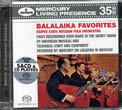
Balalaika Favorites - Osipov State Russian Folk Orchestra (titles below) - Mercury Living Presence 3-Channel SACD 475 6610, 49:30 *****
First, I was surprised to find that this new hi-res reissue of the original Mercury album has exactly the same 14 tracks as the original and the Classic Records vinyl reissue—totaling 49 minutes! That's nothing special on a SACD or CD but it certainly was on a high-level audiophile LP back in 1963 when the disc came out. Plus Mercury tended to master their LP grooves at a very high level. Perhaps they squeezed on a bit more by going closer to the center label than did other labels. In fact one side of the Classic reissue I have gets equally close to the label—so much so that when I had an automatic arm lift it would lift before the disc was ended.
This was part of the famous On Location recordings in which Mercury Records took their entire recording van and equipment to Moscow and made the first recordings in the Soviet Union for an American musical and technical staff. They used 35mm magnetic film for this recording session, with its much wider tracks and better signal-to-noise specs. Piano concertos and solo works featuring Byron Janis got the most attention, but this particular album featuring the large Russian folk orchestra was great fun then and still is. The orchestra is heavy on various plucked stringed instruments, giving a unique ensemble sound. They include varieties of the Russian mandolin, the domra. The balalaika is the familiar Russian folk instrument and also comes in many sizes, with the contrabass models being huge triangular-shaped instruments. Other instruments include the Shepherd's Horns and an ancient twangy one or two-stringed instrument called the Goosli.
Obviously a comparison of the SACD and the Classic vinyl reissue would be in order. I was impressed by how very similar they were. The general timbre was almost identical. The main difference was that the LP produced a sort of semi-U-shaped soundstage whereas the three-channel SACD laid out the orchestra straight across the front with the occasional solo instrument front and center with amazing presence. The two-channel SACD matched more closely with the vinyl, as expected. Adding ProLogic II processing to the vinyl created a very nice surround field but my preamp doesn't allow adding this to the multichannel SACD playback. In general the SACD—both two and three-channel options—brought the players a bit closer to the listener than did the vinyl, but not by a huge distance. The mix of familiar classical works by Tchaikovsky, Rimsky-Korsakov and others with a few tunes known in the West such as Midnight in Moscow give a good balance with the unfamiliar but enthusiastically melodic Russian folk tunes. A truly delightful album in delightful sonics via any format.
Tracks: Fantasy on Two Folk Songs, At Sunrise, The Linden Tree, Kamarinskaya, Fantasy on Volga Melodies, In the Moonlight, Midnight in Moscow, Under the Apple Tree, Dance of the Comedians, The Living Room, Evening Bells, My Dear Old Friend Please Visit Me, Waltz of the Faun, Flight of the Bumblebee. John Sunier
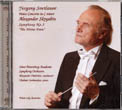
YEVGENY SVETLANOV: Piano Concerto in C Minor; SCRIABIN: Symphony No. 3 "The Divine Poem" - Saint Petersburg Academic Symphony Orchestra/Alexander Dmitriev; Vladimir Ochinnikov, piano - Water Lily Acoustic Stereo-only SACD SWA-WS-75-SACD ****
The Svetlanov concerto is quite a surprise. This important figure in Soviet musical life is known in the West as a conductor—not a pianist or composer—which it seems he equally was. He was writing under the thumb of the Soviet system which insisted on conservative and super-accessible music for the masses. As a pianist in his own right he was very familiar with the great Romantic piano concertos and emulated some of their virtuoso qualities in his two-movement concerto. Some of the themes are highly romantic and almost Hollywoodish but thoroughly delightful—providing an interesting contrast with the serialized dogma which had become solidified in Western academia at the time. This concerto would be a big hit on U.S. concert programs if it were performed today.
The Third Symphony of Scriabin predates his most experimental musical works and sounds like modernized Tchaikovsky, but its outline shows his predilection for optimistic and mystical philosophies. Transfiguration of the "hero" of this work and his leaving behind earthbound restraints is part of the program. The work is a lush hothouse jungle of orchestral perorations. The purist two-mike recording approach used here by Water Lily seems to aid the music taking wing better than other technical means. And nobody does Scriabin like the Russians. The moment the opening of the work was heard I started to get goose-bumps, but be warned I'm a nut on Scriabin.
I don't know why only this one of the Water Lily St. Petersburg recordings was released stereo-only instead of mixed for multichannel as in the others, but I found feeding it thru Pro Logic II achieved a very enjoyable surround field. One observation applies to all of the Water Lily hi-res offerings: the realism of the applause at the end of the performances is startling. One of the very best tests of fidelity is how much the applause sounds like the real thing. And this does - more than I've heard on any other recent live recording. Could be the lack of phase cancellation due to the purist Blumlein mic'ing, I don't know, but it's quite astounding. Even more so on the surround SACDs, which reminded me of the realism of binaural recordings I have made sitting in churches and halls where people were applauding around me. John Sunier
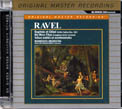
RAVEL: Daphnis et Chloé (Ballet Suites 1 & 2); Mother Goose Suite (complete ballet version); Valses nobles et sentimentales - Minnesota Orchestra/Stanislaw Skrowaczewski - Vox/Mobile Fidelity multichannel SACD Original Master Recording, UDSACD 4008 *****
We have here another of the audiophile-favored recording projects of the Joanna Nickrenz and Marc J. Aubort team for Vox Records. The original LP was released in l975 and it was a QS quadraphonic disc. Actually it must have been two discs because the length of this program would never fit on the two sides of a single LP—the Mother Goose Suite alone is a half hour length. Mo-Fi's mastering expert Paul Stubblebine used their Gain 2 System, which stands for Greater Ambient Information Network and includes both a custom analog tape playback system and custom A-to-D converter and input drivers. The original four channels were preserved in the transfer, with no attempt to mix to 5.0 or 5.1.
Marc Aubort contributes some of the liner notes for the reissue and the notes from the original release are also reprinted. There have been several hi-res Daphnis and Chloes lately. The Boston Symphony version of 1955, just reissued by RCA on SACD, is only two channel but benefits from the glorious and rich sonic picture provided by the BSO, choruses and conductor Charles Munch. It is also the complete 55-minute ballet rather than the half-hour combo of the two suites. Although the Minnesota Orchestra is obviously not the BSO, the clean and skillfully-deployed surround field involves one in the performance more than the RCA version. The chorus on the Mo-Fi version is completely uncredited, but seems to be heard in some sections of the music where there is no chorus heard on the complete ballet score version. It is strongly on the surround channels and therefore brings more attention to itself as it contributes to the lush and fantastical mood of Ravel's masterful impressionistic score. The Ma Mere l'Oye Suite is also a delight, coming not that long after the original two-piano version on one of our recent Multichannel Discs of the Month (Argerich and Pletnev). John Sunier
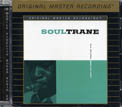
John Coltrane (with Red Garland, Paul Chambers & Arthur Taylor) - SoulTrane - Prestige/Mobile Fidelity mono SACD UDSACD 2020 ****
Not to be outdone by the flurry of mono vinyl reissues that seem to be issued lately, the SACD is camp is not averse to reissuing a great jazz classic in mono if it features a name like Coltrane or Miles, and especially if it's one of Rudy Van Gelder's "deep mono" recordings from the 1950s. Few unwitting listeners would realize this was a mono recording—especially with the added details and presence provided by the transfer to SACD. It dates from 1958, taped in Rudy's home studio in Hackensack, New Jersey. Between the already superb 1/4-inch master tape and the DSD transfer Mobile Fidelity employed a highly modified open reel deck with new electronics and heads by Tim de Paravicini and their Ultradisc UHR Gain 2 transfer technology to wring the utmost fidelity out of these five tracks. And good for Mo-Fi clearly labeling the SACD "Monaural" rather than disguising that information unlike many other reissues.
Coltrane had the same sidemen for this session that had graced his previous Prestige LP. Pianist Red Garland was an original; he had the ability to swing like mad but seemingly without any effort at all. The tunes are all off the beaten track, and Coltrane stresses the melodic in most of his solos, only approaching his more free "sheets of sound" later improvisations in the last track, Russian Lullaby. This album has been a winner since its inception but now it comes across with a renewed life and naturalness not heard before.
Tracks: Good Bait, I Want to Talk About You, You Say You Care, Theme for Ernie, Russian Lullaby. John Henry
Reviews reprinted with permission from Audiophile Audition

